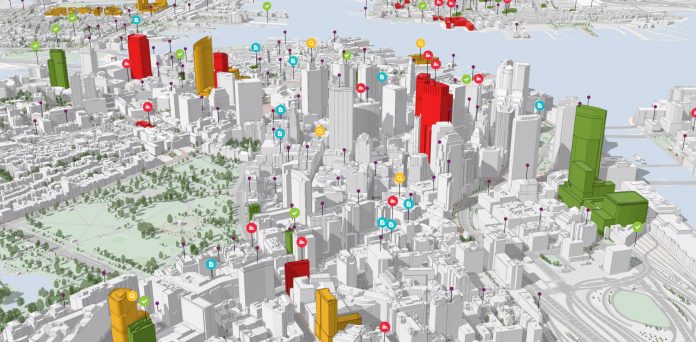Craig Evenden, head of architecture, engineering, construction & BIM at Esri UK, examines the current state of digital twins and what the future holds
Over the past decade, there has been a rapid advance in technology, which has led to the evolution of the digital twin. Within the AEC sector, early adopters are bringing together GIS and BIM, representing proposed 3D projects within the environment in which they will be built.
Esri has been creating digital twins in some form since 1969. In the early days, they were more 2D digital representations of the natural and built environment. Today, we are creating 3D visualisations and along with the rise of BIM, smart sensors and IoT, these are now living, breathing information models.
Moving from a macro to a micro engagement, digital twins are now also enabling smarter buildings via indoor mapping, supporting facility management, indoor navigation or real-time people and asset tracking. Indoor mapping provides users with interactive digital twin floorplans, helping to improve operational efficiency by giving staff a clear picture of where things are and how to reach them.
How are factors like IoT data, improved standards and interoperability helping advance digital twins?
This is a critical area. Initiatives like Digital National Asset Register (DNAR) and National Underground Assets Register (NUAR) are key steps in standardising and making important information available. However, the value of this data is very significant and organisations will not want to give away this revenue stream.
With advances in technology such as IoT, improved standards and greater interoperability between GIS and BIM, we now have access to a wealth of data. This has allowed users to adopt new and innovative workflows, such as deep learning (DL) or artificial intelligence (AI), gaining a greater level of insight into data that has not been possible to achieve before.
Digital twins are a key component of decision-making within any construction project. They improve business process, reduce risk and optimise operational efficiencies. It is therefore vital they are made available to the project owners throughout the process, not just at the end, as part of a completed project handover. They allow users to analyse and predict issues before they occur and help the construction process keep on track with the design.
How do GIS and BIM work together in digital twins?
GIS complements BIM by mapping and visually displaying the land and features surrounding a site. By showing the interrelationships between a project and the nearby terrain, GIS reveals how a structure will interact with the connected world. With that visibility, AEC planners can increase productivity and minimise costs from unexpected site impediments or late design changes.
Many companies are integrating drones into digital twin workflows for additional productivity gains. High-definition drone imagery can be integrated with GIS and BIM, so planners can quickly see highly realistic 3D models of a project, giving a near real-time view of the current status.
In the past, GIS and BIM were siloed and could not easily share data. Now the two are reaching new levels of interoperability, giving designers and business leaders a seamless picture of a building under construction and a common platform for collaboration and communication with stakeholders.
The construction industry is poised for massive growth if it can embed these sorts of workflows within projects. Geospatial technology, drone-based imagery and building modelling are the kind of cutting-edge digital tools industries across the board employ to accelerate efficiency and productivity.
How will digital twin technology continue to evolve?
Caution needs to applied as “digital twin” is a broad term, which can mean different things to different people and used to cover two very different digital representations. There are two paths here and both need to be considered.
The first is the creation and adoption of basic digital twins. These 3D representations of the built and natural environment will continue to move at pace, become more standardised and accepted/demanded by customers.
The second is the adoption of detailed digital twins (information models), which will take far longer. The technology required to create these has been around for some time but access to the vast amount of data needed remains a challenge. Coming from multiple sources gives rise to inaccuracies, lack of standardisation and interoperability issues.
Today, you will see lots of detailed digital twins on projects and at a small scale; however, national digital twins won’t be around for some time. Utility companies, engineering firms, government and healthcare will have to make their data available and easily accessible to the masses for these to happen more easily. Many won’t want to do this as they sell data as premium content while others will be rightly nervous about data privacy issues and accountability. This challenge will take much longer to solve and one that needs to be driven by policy and government
Organisations such as the Centre for Digital Built Britain and its National Digital Twin programme, along with the DNAR and NUAR initiatives will help evolve this over time, but they need to recognise geospatial as an important component in creating, capturing and maintaining digital twins. Digital twins are not only about the built environment but the natural world too.
Craig Evenden
Head of architecture, engineering, construction & BIM
+44 (0)1296 745599
Twitter: esriuk
LinkedI: esriuk














